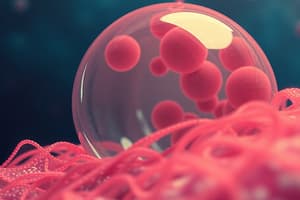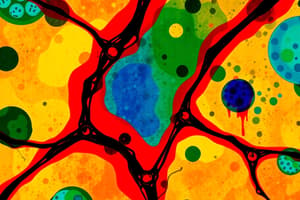Podcast
Questions and Answers
A scientist is studying the movement of a new drug across the cell membrane. They observe that the drug readily passes through the membrane without the assistance of membrane proteins. Which property of the drug is most likely facilitating this?
A scientist is studying the movement of a new drug across the cell membrane. They observe that the drug readily passes through the membrane without the assistance of membrane proteins. Which property of the drug is most likely facilitating this?
- The drug is large and water-soluble.
- The drug is small and lipid-soluble. (correct)
- The drug is repelled by lipids.
- The drug is positively charged.
If a researcher is studying cells and wants to disrupt the structural support, which cellular component should they target?
If a researcher is studying cells and wants to disrupt the structural support, which cellular component should they target?
- Integral proteins
- Cholesterol
- Glycolipids
- Cytoskeleton (correct)
A cell needs to import a specific type of large, polar molecule. Which transport mechanism would it most likely use?
A cell needs to import a specific type of large, polar molecule. Which transport mechanism would it most likely use?
- Direct integration into the phospholipid bilayer
- Transport through an ungated channel protein
- Transport via a carrier (gated) protein (correct)
- Simple diffusion through the phospholipid bilayer
Which component of the cell membrane contributes primarily to its rigidity and firmness?
Which component of the cell membrane contributes primarily to its rigidity and firmness?
A scientist discovers a new type of cell and finds that it is unable to distinguish between different blood types. Which membrane component is likely malfunctioning?
A scientist discovers a new type of cell and finds that it is unable to distinguish between different blood types. Which membrane component is likely malfunctioning?
How would blocking the function of integral proteins directly impact a cell?
How would blocking the function of integral proteins directly impact a cell?
After analyzing a sample, it is found that the concentration of sodium ions is higher outside of a cell than inside. Which fluid compartment would you expect to have been sampled?
After analyzing a sample, it is found that the concentration of sodium ions is higher outside of a cell than inside. Which fluid compartment would you expect to have been sampled?
A viral infection damages the cell membrane, specifically affecting its ability to regulate the passage of substances. Which function of the cell membrane is most directly compromised?
A viral infection damages the cell membrane, specifically affecting its ability to regulate the passage of substances. Which function of the cell membrane is most directly compromised?
Which cellular component is directly involved in modifying and packaging proteins for secretion from the cell?
Which cellular component is directly involved in modifying and packaging proteins for secretion from the cell?
A cell requires ATP to perform an energy-demanding task. Which organelle is primarily responsible for producing this ATP?
A cell requires ATP to perform an energy-demanding task. Which organelle is primarily responsible for producing this ATP?
Which of the following structures is NOT bound by a lipid membrane?
Which of the following structures is NOT bound by a lipid membrane?
Following synthesis on the rough ER, a protein destined for secretion takes a specific route through the cell. Which of the following correctly outlines this pathway?
Following synthesis on the rough ER, a protein destined for secretion takes a specific route through the cell. Which of the following correctly outlines this pathway?
In cells lining the respiratory tract, which of the following structures helps to move mucus and trapped particles out of the lungs?
In cells lining the respiratory tract, which of the following structures helps to move mucus and trapped particles out of the lungs?
How do lysosomes and peroxisomes collaborate in maintaining cellular health?
How do lysosomes and peroxisomes collaborate in maintaining cellular health?
If a researcher is studying a cell and observes a high concentration of licorice-looking structures, what process is most likely occurring in that cell?
If a researcher is studying a cell and observes a high concentration of licorice-looking structures, what process is most likely occurring in that cell?
A cell is observed to have an increased surface area due to numerous short, finger-like projections. What is the primary function of these projections?
A cell is observed to have an increased surface area due to numerous short, finger-like projections. What is the primary function of these projections?
Flashcards
Cytosol
Cytosol
The fluid inside a cell, including organelles.
Nonmembranous Organelles
Nonmembranous Organelles
Cell structures NOT enclosed by a lipid membrane; directly contact the cytosol.
Membranous Organelles
Membranous Organelles
Structures in cell surrounded by a lipid membrane.
Microvilli
Microvilli
Signup and view all the flashcards
Centrioles
Centrioles
Signup and view all the flashcards
Cilia
Cilia
Signup and view all the flashcards
Ribosomes
Ribosomes
Signup and view all the flashcards
Golgi apparatus
Golgi apparatus
Signup and view all the flashcards
Cytology
Cytology
Signup and view all the flashcards
Extracellular Fluid
Extracellular Fluid
Signup and view all the flashcards
Intracellular Fluid
Intracellular Fluid
Signup and view all the flashcards
Cell Membrane
Cell Membrane
Signup and view all the flashcards
Phospholipid Bilayer
Phospholipid Bilayer
Signup and view all the flashcards
Integral and Peripheral Proteins
Integral and Peripheral Proteins
Signup and view all the flashcards
Cholesterol in Cell Membrane
Cholesterol in Cell Membrane
Signup and view all the flashcards
Glycolipids
Glycolipids
Signup and view all the flashcards
Study Notes
- Cytology is the study of the structure and function of cells.
- There are two kinds of cells: somatic and sex cells.
- Extracellular fluid is fluid outside of the cell and goes by other names such as water, tissue fluid, and interstitial fluid.
- Intracellular fluid is fluid inside of the cell known as cytosol.
- Extracellular and intracellular fluids can become each other.
- The most important part of the cell is the cell membrane.
- The cell membrane provides structural support, regulation, and physical isolation.
- Physical isolation by the membrane separates one cell from another.
- Cell membrane regulation regulates what goes in and out of the cell.
- Cell membrane is a phospholipid bilayer that also has proteins and lipid carbohydrates.
- There are 5 sections in the cell: phospholipid bilayer, integral/peripheral proteins, cholesterol, glycolipids (carbohydrates), and cytoskeleton.
- The phospholipid bilayer contains a phosphate head and 2 fatty acid tails.
- The phospholipid bilayer contains hydrophobic tails and a hydrophilic head.
- The phospholipid bilayer is touching but not connected.
- To pass through the phospholipid bilayer, molecules should be small and lipid-soluble.
- Integral proteins pass through the phospholipid bilayer, while peripheral proteins stay inside.
- Integral and peripheral proteins are used for transport in and out of the cell and do not need to be lipid-soluble.
- Integral and peripheral proteins are hydrophilic.
- Viruses and small molecules can pass through the integral and peripheral proteins.
- Integral and peripheral proteins are ungated and gated channels.
- Cholesterol helps with rigidity/firmness.
- Glycolipids are also known as carbohydrates.
- Glycolipids help recognize blood type.
- Glycolipids are sugar, polysaccharide, and carbohydrate chains.
- The cytoskeleton is the structure of the cell.
- The cytoskeleton gives the cell its frame.
- Membrane proteins are channels and gated proteins.
- A channel is a tube with no gate.
- A carrier protein is a gated channel that needs a key to carry through.
- Cytoplasm is cytosol with all the organelles/all the stuff inside with the organelles.
- Nonmembranous structures have no membrane, always touching cytosol.
- There are 6 nonmembranous structures: cytoskeleton, microvilli, centrioles, cilia, ribosomes, and proteasomes.
- Membranous structures are surrounded by a lipid membrane.
- There are 6 membranous structures: endoplasmic reticulum, Golgi apparatus, lysosomes, peroxisomes, and mitochondria.
- Microvilli are short finger-looking things on the cell.
- Microvilli increase the surface area.
- Microvilli come in contact and absorb.
- Centrioles are used during mitosis (reproduction).
- Centrioles look like licorice.
- Cilia pushes everything in one direction (up).
- Cilia have a layer of mucus.
- Cilia are used for movement but only on the top.
- Cilia are like flagella, but multiple.
- Cilia look like short finger-looking things on the cell.
- Flagella are long, moving cells attached to only one, while cilia are short and move a substance, multiple.
- Ribosomes look like little black dots.
- Ribosomes make proteins.
- Ribosomes are located attached to rough ER or free.
- There are 2 kinds of endoplasmic reticulum: rough and smooth.
- Rough ER has ribosomes and makes proteins.
- Smooth ER has no ribosomes, makes lipids, and aids detoxification.
- Endoplasmic reticulum looks like stadium seating and is usually around the nucleus.
- The Golgi apparatus packages proteins.
- The Golgi is located next to the rough ER.
- The Golgi looks layered.
- The Golgi cycle goes from rough ER to Golgi to sending it out.
- Lysosomes and peroxisomes look the same and are for clean-up.
- Lysosomes digest.
- Peroxisomes neutralize toxins.
- Lysosomes and peroxisomes look like circles, but lysosomes are bigger.
- Mitochondria is used for making ATP.
- Mitochondria looks like a bean.
- Cristae are folds for more surface area in the mitochondria.
- The matrix is the fluid inside the mitochondria.
- The nucleus is the control center.
- Protein synthesis happens in the rough ER.
- An amino acid chain makes protein.
- Permeability is when everything goes in and out.
- Impermeability is when nothing goes in or out.
- Selectively permeability is when some things go in or out.
- Cell membranes are selectively permeable.
- Diffusion is a way of movement.
- Diffusion is an area from going from high to low.
- Diffusion stops when it's equilateral.
- Diffusion is passive and doesn't take ATP.
- Osmosis is the diffusion of water across a semipermeable membrane.
- Osmosis must have water.
- Osmotic pressure is the force of water movement into solute.
- The three things needed for osmosis are water, semipermeable membrane, and solid difference.
- In osmosis, water always goes to higher solutes.
Studying That Suits You
Use AI to generate personalized quizzes and flashcards to suit your learning preferences.




